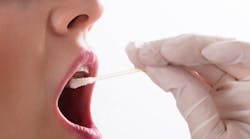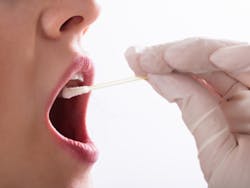I recently had the opportunity to visit OralDNA Labs and learn more about the process of running salivary diagnostic tests. Admittedly, when I first heard about salivary diagnostics, I didn’t immediately embrace the tests and what they had to offer. I was not convinced that they were necessary, believing they would not change how we treat dental disease.
However, we’ve been fortunate to use salivary diagnostics in practice and see the benefits in our patients firsthand. These tests have proven to be a great addition to our prevention tool box. Salivary diagnostics can play an important role in helping us produce high quality outcomes for patients and create awareness of their oral-systemic risk factors.
Bacterial identification
There are numerous salivary diagnostic tests available. The most widely used test from OralDNA Labs is MyPerioPath, which tests for the 11 pathogens that are known to contribute to periodontal destruction.(1) Once the test reveals which pathogens are contributing to the patient’s periodontal disease, it also offers antibiotic recommendations that target these specific bacteria.
When combined with periodontal maintenance visits and patient homecare, this test can lower a patient’s bacterial load, thus increasing positive outcomes. Retesting has shown that this reduction in bacteria can have a dramatic effect. We’ve seen tough cases—patients who were compliant with homecare but still exhibited clinical signs of periodontal disease—that improved dramatically after being treated with the test’s recommended systemic antibiotic. Periodic monitoring with MyPerioPath combined with periodontal maintenance treatment can help keep patients’ oral health stable.
Genetic predisposition
In addition to bacterial profile testing, various tests from OralDNA labs can tell us a patient’s genetic predisposition toward inflammation. This can reveal one of the reasons why some patients continue to experience periodontal destruction after treatment despite compliance and lower quantities of periodontal pathogens. In addition, much of the research connecting oral health to systemic conditions reveals that it is a patient’s total inflammatory burden that puts someone at risk for a host of health problems.(2,3)
While the patient’s genetic profile cannot be changed, the knowledge that the person has an overactive inflammatory response can help the practitioner and patient understand that there is a need for more frequent continuing care, adjunctive therapies, or treatment with a periodontist. This information can also help patients manage and control their systemic health with the help of their physician.
Caries risk assessment
When we look beyond the patient’s periodontal health, salivary diagnostics can also test for the bacteria that are known to contribute to caries. When we have an objective measure of the quantity and types of cariogenic bacteria in the patient’s mouth, we can once again tailor treatments to reduce his or her caries risk and motivate the patient toward behavioral change. If we then combine the test with a caries risk assessment tool, we can use the test to monitor the effectiveness of these behavior changes. Knowing the patient’s risk allows us to encourage the person to use interventions, such as fluoride to re-mineralize teeth and xylitol to inhibit the bacterial metabolism.
Oral cancer screening
Finally, salivary diagnostics can also test for the presence of various human papillomavirus (HPV) strains that have been shown to cause oral cancer. According to the American Cancer Society, oral cancer will take the lives of 10,860 people this year, and HPV is now seen as the leading cause.(4,5) Early diagnosis is key and increases survival from a dismal 20% when discovered after it has metastasized to distant sites, to 93% when discovered early.(6)
Knowing a patient’s HPV status may prompt us to increase the frequency of someone’s oral cancer screenings, or to use adjunctive diagnostic tools such as oral anomaly detection devices to more closely monitor the patient and potentially catch the cancer at an earlier stage.
More and more research studies are correlating the various bacteria that cause periodontal disease to systemic conditions. The more we understand about a patient’s bacterial load and risk factors, the better equipped we can be to help manage periodontal disease and improve overall health. Salivary diagnostics can help us provide optimal care for patients, increasing our ability to provide them with positive outcomes through tailored treatment and patient education.
Barbara Kreuger, MA, RDH,earned a Bachelor of Science in dental hygiene from the University of Minnesota and holds a Master of Arts in organizational leadership from St. Mary’s University of Minnesota. She spent more than 18 years as a clinical dental hygienist before moving to her current role as dental hygiene senior specialist for Pacific Dental Services. Barbara is currently serving as president of the Minnesota Dental Hygienists’ Association.
References
1. Oral DNA tests. OralDNA website. https://www.oraldna.com/tests.html. Accessed February 1, 2019.
2. Hunter P. The inflammation theory of disease. The growing realization that chronic inflammation is crucial in many diseases opens new avenues for treatment. EMBO Rep. 2012;13(11):968-70.
3. Minihane AM, et al. Low-grade inflammation, diet composition and health: current research evidence and its translation. Brit Jour Nutrition. 2015;114(7):999–1012.
4. Key Statistics for Oral Cavity and Oropharyngeal Cancers. American Cancer Society website. https://www.cancer.org/cancer/oral-cavity-and-oropharyngeal-cancer/about/key-statistics.html. Accessed February 1, 2019.
5. HPV/Oral Cancer Facts. Oral Cancer Foundation website. https://oralcancerfoundation.org/understanding/hpv/hpv-oral-cancer-facts/. Accessed February 1, 2019.
6. Survival Rates for Oral Cavity and Oropharyngeal Cancer. American Cancer Society website. https://www.cancer.org/cancer/oral-cavity-and-oropharyngeal-cancer/detection-diagnosis-staging/survival-rates.html. Accessed February 1, 2019.






